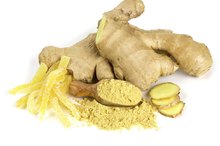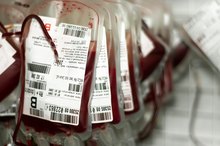Light Red Blood Streaks in Phlegm
Phlegm, or sputum, is produced when the lungs are inflamed and excess mucous is produced in the respiratory tract. The medical term for blood in the sputum is hemoptysis. According to MedlinePlus, blood in the sputum differs from bleeding that comes from the mouth, stomach or throat because it contains air bubbles combined with mucous 1. Blood mixed with phlegm could be bright red, rust colored or streaked with red.
If you are experiencing serious medical symptoms, seek emergency treatment immediately.
Common Causes
According to American Family Physician, the usual causes of blood in phlegm are pneumonia, bronchitis and lung cancer in adults. In children, lower respiratory tract infections and aspiration of foreign objects are common reasons for hemoptysis. Bronchitis and pneumonia are infections caused by bacteria or viruses. Blood in the nose associated with respiratory infection and postnasal drip can result in red streaks in the phlegm, as can uncontrolled coughing 13. Laryngitis can irritate the throat, leading to blood-tinged sputum.
- According to American Family Physician, the usual causes of blood in phlegm are pneumonia, bronchitis and lung cancer in adults.
- Blood in the nose associated with respiratory infection and postnasal drip can result in red streaks in the phlegm, as can uncontrolled coughing 1.
Other Conditions
What Is the Acceptable Range for Eosinophils?
Learn More
Patients with heart disease can develop a condition known as pulmonary edema. The disease causes increased pressure in the lungs, congestion and bloody sputum. A blood clot that forms in the lung or travels from a deep vein leg thrombosis, known as pulmonary embolism, can lead to blood-tinged sputum.
Testing
Chest X-rays and blood tests are used to detect infection and bleeding disorders to find common causes of hemoptysis. A computed tomographic scan of the chest might be ordered to detect tumors, infiltrates and blood clots. A test known as a bronchoscopy might be performed to look directly at lung tissue. A scope is passed into the lung under sedation to directly visualize the airways. If tumor or autoimmune disorder is suspected, your physician might schedule a biopsy.
- Chest X-rays and blood tests are used to detect infection and bleeding disorders to find common causes of hemoptysis.
- A computed tomographic scan of the chest might be ordered to detect tumors, infiltrates and blood clots.
Recommendations
Can Riding a Bicycle Cause Blood in the Urine?
Learn More
Blood in phlegm, accompanied by shortness of breath, dizziness, more than a few teaspoons of blood, chest pain, fever or bleeding with urination or defecation requires immediate medical care, according to MedlinePlus 1. Before using cough suppressants for bronchitis, pneumonia or other respiratory conditions, consult your physician. Clearing the airway of sputum is important. In some cases, taking cough syrup can lead to airway obstruction. According to MayoClinic.com, coughing up a small amount of blood is common and not usually a cause for alarm 13.
Related Articles
References
- MedlinePlus: MedlinePlus: Coughing Blood
- “American Family Physician”; Hemoptysis: Diagnosis and Management; Jacob L. Bidwell, M.D, October 2005
- MayoClinic.com: Coughing up Blood
- Pabreja K, Gibson P, Lochrin AJ, Wood L, Baines KJ, Simpson JL. Sputum colour can identify patients with neutrophilic inflammation in asthma. BMJ Open Respir Res. 2017;4(1):e000236. doi:10.1136/bmjresp-2017-000236
- Gershman E, Guthrie R, Swiatek K, Shojaee S. Management of hemoptysis in patients with lung cancer. Ann Transl Med. 2019;7(15):358. doi:10.21037/atm.2019.04.91
- Davidson K, Shojaee S. Managing massive hemoptysis. Chest. 2019; doi:10.1016/j.chest.2019.07.012
- Budzinski T. Chronic bronchitis. Contemporary Clinic. April 18, 2017.
- U.S. National Library of Medicine. Routine sputum culture. Updated November 20, 2017.
- Xiang D, Zhang B, Doll D, Shen K, Kloecker G, Freter C. Lung cancer screening: from imaging to biomarker. Biomark Res. 2013;1(1):4. doi:10.1186/2050-7771-1-4
- Shen Y, Huang S, Kang J, et al. Management of airway mucus hypersecretion in chronic airway inflammatory disease: Chinese expert consensus (English edition). Int J Chron Obstruct Pulmon Dis. 2018;13:399-407. doi:10.2147/COPD.S144312
Resources
Writer Bio
Kathleen Blanchard is a registered nurse, with more than 10 years of experience in cardiovascular health, emergency room and ICU. She writes professionally for Emaxhealth.com. and AskMen.com. Blanchard is currently employed as a senior case manager and has held certification as a critical care registered nurse (CCRN), advanced trauma life support (ATLS), and advanced cardiac life support (ACLS).









